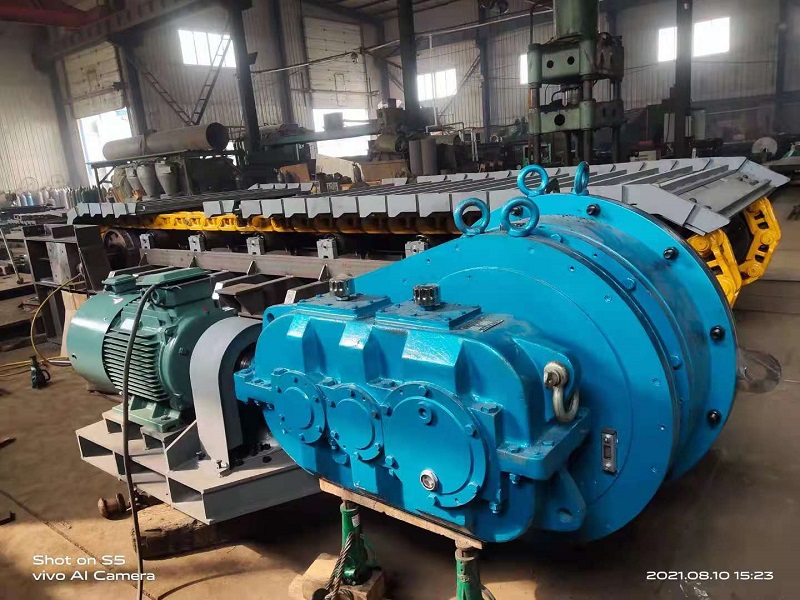Working principle of Heavy Duty Apron Feeder
Heavy Duty Apron Feeder
Working principle of Heavy Duty Apron Feeder
Heavy Duty Apron Feeder is a type of equipment used for material transportation and feeding, typically used in industries such as mining, metallurgy, building materials, and chemical engineering. Its working principle is based on the coordinated operation of plate conveyor belts and transmission devices.

The following are the general steps for the working principle of a Heavy Duty Apron Feeder:
Material loading: Materials are loaded onto the upper or side of the feeder through loading equipment such as excavators or loaders.
Transportation: Through the transmission device, the conveyor belt of the feeder starts to operate, conveying materials forward along the conveyor line of the feeder.
Inclined conveying: The conveyor belt of a heavy Duty Apron Feeder is inclined, which causes rolling motion of the material during transportation and pushes it forward.
Transfer: The conveyor belt transfers materials from the upper or side of the feeder to the target location below, which can be other equipment, containers, or processing facilities.
Gravity assisted: In some cases, the conveyor belt of the feeder may be equipped with auxiliary devices, such as rollers or rollers, to push the material downhill through gravity assisted, increasing conveying efficiency.
Adjustment and control: The feeder is usually equipped with an adjustment device that can adjust the speed and inclination angle of the conveyor belt as needed to control the material flow and feeding speed.
In general, Heavy Duty Apron Feeder transfer materials from above or to the target position through conveyor belts and transmission devices, and achieve material pushing and conveying through tilt angle and gravity assistance. By appropriate adjustment and control, it can meet the requirements of different working scenarios for material handling.
 O'zbek
O'zbek slovenský
slovenský Azərbaycan
Azərbaycan Қазақ
Қазақ Latine
Latine ລາວ
ລາວ български
български नेपाली
नेपाली فارسی
فارسی Javanese
Javanese Українська
Українська Lietuvos
Lietuvos Română
Română Slovenski
Slovenski پښتو
پښتو Punjabi
Punjabi Bosanski
Bosanski Malti
Malti Galego
Galego Afrikaans
Afrikaans Esperanto
Esperanto 简体中文
简体中文 Српски
Српски मराठी
मराठी Ελληνικά
Ελληνικά čeština
čeština Polski
Polski ไทย
ไทย Nederlands
Nederlands Italiano
Italiano Tiếng Việt
Tiếng Việt Deutsch
Deutsch français
français русский
русский Português
Português Español
Español 한국어
한국어 Svenska
Svenska Malay
Malay اردو
اردو norsk
norsk Indonesia
Indonesia عربى
عربى Gaeilge
Gaeilge Türk
Türk Pilipino
Pilipino हिन्दी
हिन्दी Dansk
Dansk বাংলা
বাংলা English
English


What is a Metering Conveyor
In modern material handling systems, efficiency and precision are critical to maintaining smooth operations. Among the many specialized conveyors used in industries such as packaging, food processing, mining, and logistics, the metering conveyor plays a vital role. But what exactly is a metering conveyor, and why is it becoming increasingly important in production environments?
Read MoreJuli Engineering Gains Global Recognition Among Mining Conveyor Manufacturers
The mining industry relies heavily on efficient material handling systems to ensure productivity and safety in large-scale operations. Among the many solutions available, mining conveyors stand out as indispensable equipment for transporting bulk materials such as ore, coal, and aggregates. As demand for advanced solutions grows, Juli Engineering has established itself as one of the most reliable mining conveyor manufacturers, offering durable, high-performance systems tailored to global mining needs.
Read MoreDesign and Application of a Comprehensive Coal Spillage Handling System for Downwards Transportation Belt Conveyor
A belt conveyor with an annual production capacity of 3 million tons is installed in a main inclined roadway with a steep angle of 22°. During operation, issues such as coal overflow, spillage, and falling coal occur, particularly when transporting raw coal with high moisture content.
Read More